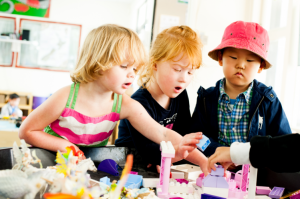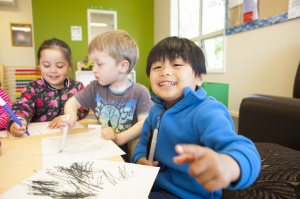In this blog, the first of a two part series, we explore the connections between The New Zealand Curriculum and Te Whāriki to better support children’s learning as they transition from early childhood education into primary school.
The New Zealand Curriculum and Te Whāriki have a similar vision for young people.
The New Zealand Curriculum has a vision for young people who will be …
"...confident, connected, actively involved, lifelong learners."
Te Whāriki aspires for children to be …
"...competent and confident learners and communicators, healthy in mind, body and spirit, secure in their sense of belonging and in the knowledge that they make a valued contribution to society."
Page 5, Te Whāriki
"There are close parallels between Te Whāriki and The New Zealand Curriculum. In both, learning is seen to take place in the space between what the educational environment offers and the knowledge and experiences that children bring with them."
Page 51, Te Whāriki
The New Zealand curriculum encourages schools to design their curriculum with the principles underpinning practice and evaluation, at the same time weaving together the values, key competencies and learning areas (Page 37, NZC).
"In Te Whāriki, learning dispositions and working theories are seen to be closely interrelated. The same is true of the key competencies and learning areas in The New Zealand Curriculum. In both cases the approach to learning recognises the need for a ‘split screen’ pedagogy that maintains a dual focus on the ‘how’ and the ‘what’ of learning."
Page 52, Te Whāriki
Local curriculum design involves a complex weaving of principles and strands (Te Whāriki), values, key competencies, and learning areas (The New Zealand Curriculum) as children and young people engage in learning experiences.
Return to top
So what are the connections between the two curriculum documents that might support children’s learning across the transition to school?
Connections through the NZC principles
"The two curriculums are based on similar principles and have similar approaches to valued learning."
Page 51, Te Whāriki
There are four principles in Te Whāriki:
-
Principle 1: Empowerment | Whakamana
Early childhood curriculum empowers the child to learn and grow.
-
Principle 2: Holistic development | Kotahitanga
Early childhood curriculum reflects the holistic way children learn and grow.
-
Principle 3: Family and community | Whānau tangata
The wider world of family and community is an integral part of early childhood curriculum.
-
Principle 4: Relationships | Ngā hononga
Children learn through responsive and reciprocal relationships with people, places and things.
There are eight principles in the NZC which should underpin all school decision making:
| NZC principle
| Examples of Te Whāriki links to NZC principles
|
|---|
High expectations
The curriculum supports and empowers all students to learn and achieve personal excellence, regardless of their individual circumstances.
|
|
Treaty of Waitangi
The curriculum acknowledges the principles of the Treaty of Waitangi, and the bicultural foundations of Aotearoa New Zealand. All students have the opportunity to acquire knowledge of te reo Māori me ōna tikanga.
|
|
Cultural diversity
The curriculum reflects New Zealand’s cultural diversity and values the histories and traditions of all its people.
|
|
Inclusion
The curriculum is non-sexist, non-racist, and non-discriminatory; it ensures that students’ identities, languages, abilities, and talents are recognised and affirmed and that their learning needs are addressed.
|
|
Learning to learn
The curriculum encourages all students to reflect on their own learning processes and to learn how to learn.
|
- In an empowering environment, children have agency to create and act on their own ideas, develop knowledge and skills in areas that interest them and, increasingly, to make decisions and judgments on matters that relate to them. Principle 1 Empowerment | Whakamana (page 18)
|
Community engagement
The curriculum has meaning for students, connects with their wider lives, and engages the support of their families, whānau, and communities.
|
- The wider world of family and community is an integral part of early childhood curriculum.
-
Whānau and community are encouraged to participate in and contribute to the curriculum.
Principle 3 Family and community | Whānau tangata (page 20)
|
Coherence
The curriculum offers all students a broad education that makes links within and across learning areas, provides for coherent transitions, and opens up pathways to further learning.
|
-
Because children develop holistically, they need a broad and rich curriculum that enables them to grow their capabilities across all dimensions. When focusing on a particular area of learning, kaiako need to consider how this focus relates to and connects with other aspects of learning and how it builds on the children’s strengths.
Principle 2 Holistic development | Kotahitanga (page 19)
|
Future focus
The curriculum encourages students to look to the future by exploring such significant future-focused issues as sustainability, citizenship, enterprise, and globalisation.
|
- As global citizens in a rapidly changing and increasingly connected world, children need to be adaptive, creative and resilient.
- Te Whāriki emphasises the development of knowledge, skills, attitudes, and dispositions that support lifelong learning. (page 7)
|
He pātai
- How closely related are the NZC principles to those of Te Whāriki?
- Which NZC principles are most effectively integrated into your school curriculum?
- Which of the Te Whāriki principles are most visible in your school curriculum?
The section on "Pathways to School and Kura" in Te Whāriki (page 51) extends on the links diagram in The New Zealand Curriculum (page 42) to show some of the ways in which the key competencies, values, and learning areas of the NZC might continue the curriculum weaving from Te Whāriki into school.
This provides a useful starting point to explore the many connections that can be made.
Return to top
Connections through the NZC values
"Values are deeply held beliefs about what is important or desirable. They are expressed through the ways in which people think and act.
Every decision relating to curriculum and every interaction that takes place in a school reflects the values of the individuals involved and the collective values of the institution.
The values on the list below enjoy widespread support because it is by holding these values and acting on them that we are able to live together and thrive. The list is neither exhaustive nor exclusive.
Students will be encouraged to value:
- excellence, by aiming high and by persevering in the face of difficulties
- innovation, inquiry, and curiosity, by thinking critically, creatively, and reflectively
- diversity, as found in our different cultures, languages, and heritages
- equity, through fairness and social justice
- community and participation for the common good
- ecological sustainability, which includes care for the environment
- integrity, which involves being honest, responsible, and accountable and acting ethically
- and to respect themselves, others, and human rights."
Page 10, New Zealand Curriculum
"Te Whāriki interprets the notion of curriculum broadly, taking it to include all the experiences, activities and events, both direct and indirect, that occur within the ECE setting. It provides a framework of principles, strands, goals, and learning outcomes that foregrounds the mana of the child and the importance of respectful, reciprocal, and responsive relationships. This framework provides a basis for each setting to weave a local curriculum that reflects its own distinctive character and values."
Page 7, Te Whāriki
"Many dispositions have been identified as valuable for supporting lifelong learning; these are termed learning dispositions. Learning dispositions associated with Te Whāriki include: courage and curiosity (taking an interest), trust and playfulness (being involved), perseverance (persisting with difficulty, challenge, and uncertainty), confidence (expressing a point of view or feeling) and responsibility (taking responsibility). Other learning dispositions include reciprocity, creativity, imagination, and resilience.
Cultural beliefs influence which learning dispositions are valued and how. Te Whatu Pōkeka highlights rangatiratanga, whakatoi, manaakitanga, and aroha as learning dispositions that are valued in te ao Māori. Others include hūmārie and whakahī."
Page 23, Te Whāriki
He pātai
- What similarities do you see between the NZC values and Te Whāriki’s learning dispositions?
- How could you/your kura work together with your local ECEs to actively support the aspirations evident in both curricula?



